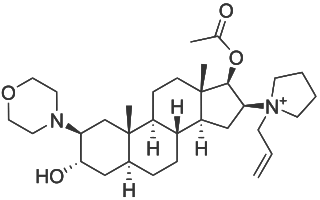
Pancuronium is an aminosteroid muscle relaxant with various medical uses. It is used in euthanasia and is used in some states as the second of three drugs administered during lethal injections in the United States.

Edrophonium is a readily reversible acetylcholinesterase inhibitor. It prevents breakdown of the neurotransmitter acetylcholine and acts by competitively inhibiting the enzyme acetylcholinesterase, mainly at the neuromuscular junction. It is sold under the trade names Tensilon and Enlon.
ATC code M03Muscle relaxants is a therapeutic subgroup of the Anatomical Therapeutic Chemical Classification System, a system of alphanumeric codes developed by the World Health Organization (WHO) for the classification of drugs and other medical products. Subgroup M03 is part of the anatomical group M Musculo-skeletal system.

Tetraethylammonium (TEA), (NEt+
4) or (Et4N+) is a quaternary ammonium cation consisting of four ethyl groups attached to a central nitrogen atom, and is positively charged. It is a counterion used in the research laboratory to prepare lipophilic salts of inorganic anions. It is used similarly to tetrabutylammonium, the difference being that its salts are less lipophilic and more easily crystallized.

Vecuronium bromide, sold under the brand name Norcuron among others, is a medication used as part of general anesthesia to provide skeletal muscle relaxation during surgery or mechanical ventilation. It is also used to help with endotracheal intubation; however, agents such as suxamethonium (succinylcholine) or rocuronium are generally preferred if this needs to be done quickly. It is given by injection into a vein. Effects are greatest at about 4 minutes and last for up to an hour.

Rocuronium bromide is an aminosteroid non-depolarizing neuromuscular blocker or muscle relaxant used in modern anaesthesia to facilitate tracheal intubation by providing skeletal muscle relaxation, most commonly required for surgery or mechanical ventilation. It is used for standard endotracheal intubation, as well as for rapid sequence induction (RSI).

Capreomycin is an antibiotic which is given in combination with other antibiotics for the treatment of tuberculosis. Specifically it is a second line treatment used for active drug resistant tuberculosis. It is given by injection into a vein or muscle.

Rapacuronium bromide is a rapidly acting, non-depolarizing aminosteroid neuromuscular blocker formerly used in modern anaesthesia, to aid and enable endotracheal intubation, which is often necessary to assist in the controlled ventilation of unconscious patients during surgery and sometimes in intensive care. As a non-depolarizing agent it did not cause initial stimulation of muscles before weakening them.

Aminosteroids are a group of steroids with a similar structure based on an amino-substituted steroid nucleus. They are neuromuscular blocking agents, acting as competitive antagonists of the nicotinic acetylcholine receptor (nAChR), and block the signaling of acetylcholine in the nervous system. These drugs include candocuronium iodide, dacuronium bromide, dihydrochandonium, dipyrandium, malouetine, pancuronium bromide, pipecuronium bromide, rapacuronium bromide, rocuronium bromide, stercuronium iodide, and vecuronium bromide.

Sugammadex, sold under the brand name Bridion, is a medication for the reversal of neuromuscular blockade induced by rocuronium and vecuronium in general anaesthesia. It is the first selective relaxant binding agent (SRBA). It is marketed by Merck.

Alcuronium chloride is a neuromuscular blocking (NMB) agent, alternatively referred to as a skeletal muscle relaxant. It is a semi-synthetic substance prepared from C-toxiferine I, a bis-quaternary alkaloid obtained from Strychnos toxifera. C-toxiferine I itself has been tested for its pharmacological action and noted to be a very long acting neuromuscular blocking agent For a formal definition of the durations of actions associated with NMB agents, see page for gantacurium. The replacement of both the N-methyl groups with N-allyl moieties yielded N,N-diallyl-bis-nortoxiferine, now recognized as alcuronium.

Pipecuronium (Arduan) is a bisquaternary aminosteroid muscle relaxant which blocks nicotinic acetylcholine receptors at the neuromuscular junction. It is also an antagonist of M2 and M3 muscarinic receptors and is the most potent neuromuscular blocking agent of the aminosteroid class.

Metocurine is a muscle relaxant through neuromuscular blockade. It is excreted entirely through the kidneys and therefore should not be used in patients with kidney failure.

Methylatropine is a belladonna derivative.

Gantacurium chloride is a new experimental neuromuscular blocking drug or skeletal muscle relaxant in the category of non-depolarizing neuromuscular-blocking drugs, used adjunctively in surgical anesthesia to facilitate endotracheal intubation and to provide skeletal muscle relaxation during surgery or mechanical ventilation. Gantacurium is not yet available for widespread clinical use: it is currently undergoing Phase III clinical development.

Candocuronium iodide is an aminosteroid neuromuscular-blocking drug. Its use in anesthesia for endotracheal intubation and to provide skeletal muscle relaxation during surgery or mechanical ventilation was briefly evaluated in clinical studies in India. However, further development was discontinued due to attendant cardiovascular effects, primarily tachycardia that was about the same as the clinically established pancuronium bromide. Candocuronium demonstrated a short duration in the body, but a rapid onset of action. It had little to no ganglion blocking activity, with a greater potency than pancuronium.

In anesthesia, neuromuscular blocking agents may be required to facilitate endotracheal intubation and provide optimal surgical conditions. When neuromuscular blocking agents are administered, neuromuscular function of the patient must be monitored. Neuromuscular function monitoring is a technique that involves the electrical stimulation of a motor nerve and monitoring the response of the muscle supplied by that nerve. It may be used from the induction of to recovery from neuromuscular blockade. Importantly, it is used to confirm adequacy of recovery after the administration of neuromuscular blocking agents. The response of the muscles to electrical stimulation of the nerves can be recorded subjectively (qualitative) or objectively (quantitatively). Quantitative techniques include electromyography, acceleromyography, kinemyography, phonomygraphy and mechanomyography. Neuromuscular monitoring is recommended when neuromuscular-blocking drugs have been part of the general anesthesia and the doctor wishes to avoid postoperative residual curarization (PORC) in the patient, that is, the residual paralysis of muscles stemming from these drugs.

Postoperative residual curarization (PORC) or residual neuromuscular blockade (RNMB) is a residual paresis after emergence from general anesthesia that may occur with the use of neuromuscular-blocking drugs. Today residual neuromuscular blockade is defined as a train of four ratio of less than 0.9 when measuring the response to ulnar nerve stimulation at the adductor pollicis muscle using mechanomyography or electromyography. A meta-analysis reported that the incidence of residual neuromuscular paralysis was 41% in patients receiving intermediate neuromuscular blocking agents during anaesthesia. It is possible that > 100,000 patients annually in the USA alone, are at risk of adverse events associated with undetected residual neuromuscular blockade. Neuromuscular function monitoring and the use of the appropriate dosage of sugammadex to reverse blockade produced by rocuronium can reduce the incidence of postoperative residual curarization. In this study, with usual care group receiving reversal with neostigmine resulted in a residual blockade rate of 43%.

Malouetine is an aminosteroid neuromuscular blocking agent and antinicotinic alkaloid isolated from Malouetia spp.

Dacuronium bromide is an aminosteroid neuromuscular blocking agent which was never marketed. It acts as a competitive antagonist of the nicotinic acetylcholine receptor (nAChR).


















